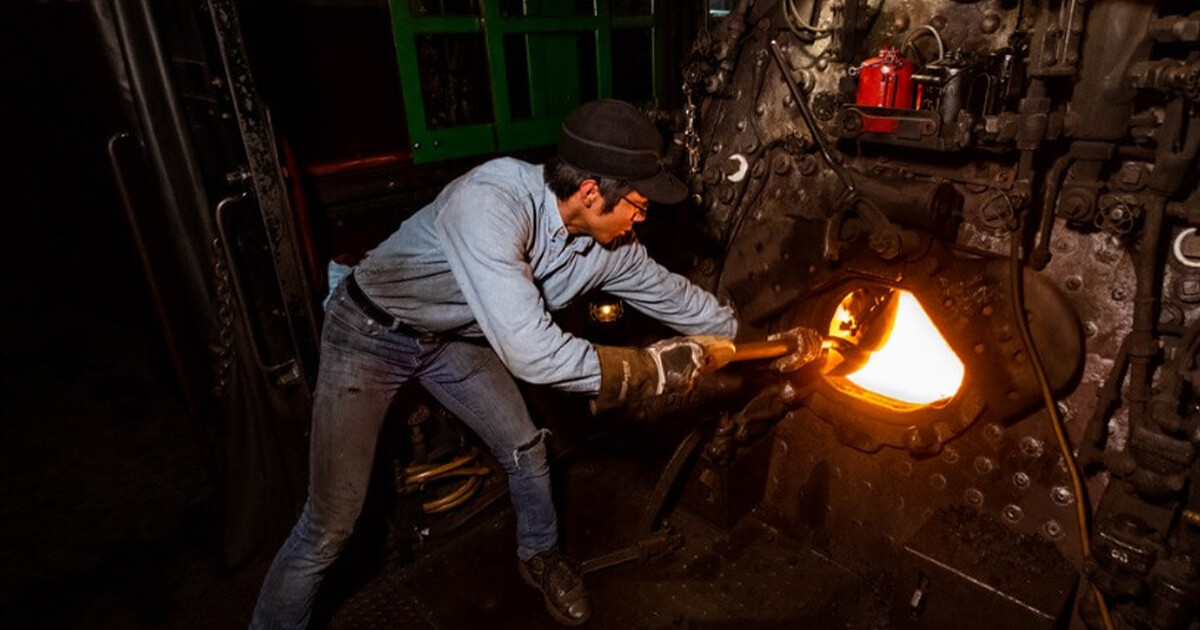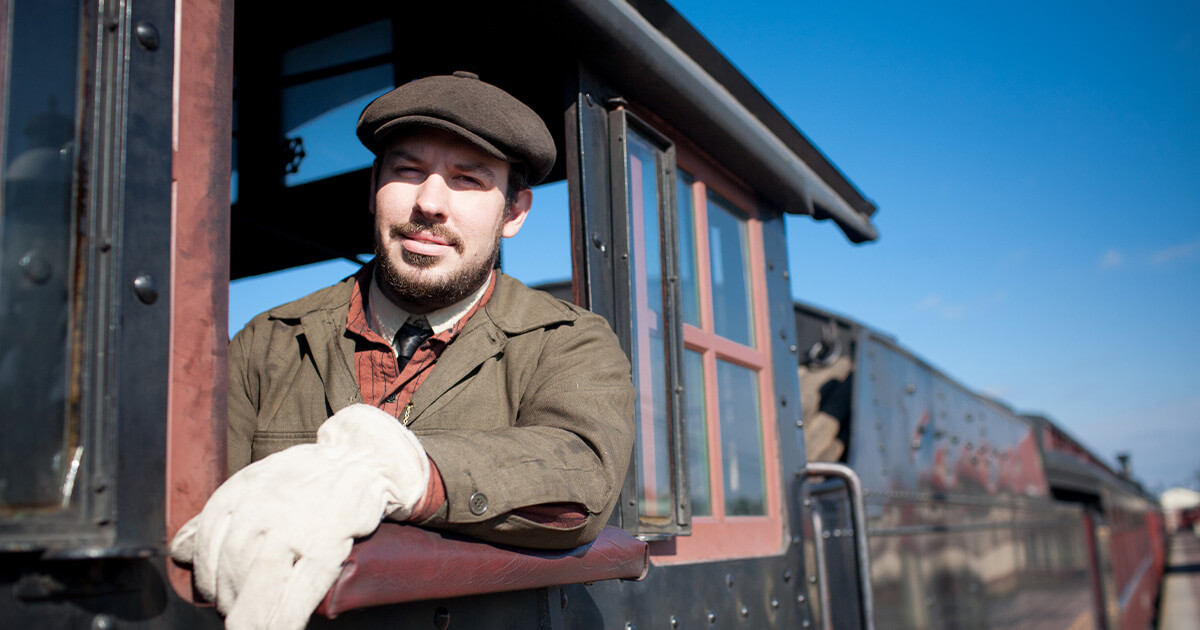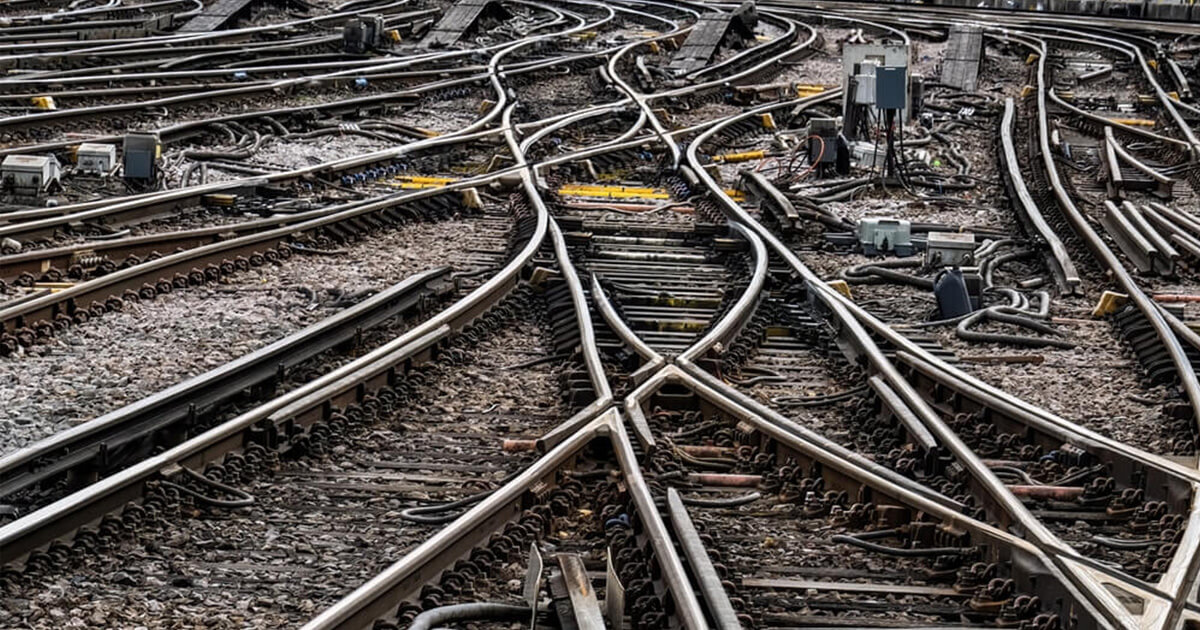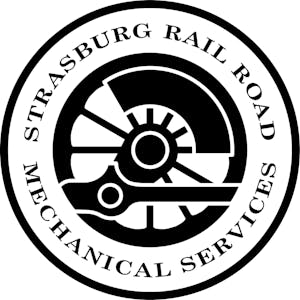6 RAILROAD WORKERS OF THE PAST AND PRESENT

Since the beginning of America’s railroading history, railroad workers have always played an essential role in maintaining the safety of the train and its passengers. From operating the locomotive to surveying the land where the tracks were laid, each person’s role was unique.
Explore the types of railroad workers that were most popular in the 19th and 20th centuries, and how their jobs evolved into the positions found on modern railways today.
19th & 20th Century Railroad Workers
In the earliest days of train transit, there were plenty of roles on- and off-board that needed to be filled by railroad workers. Below are six of the most important positions that played crucial roles in safe freight and passenger services:
1. Locomotive Engineer
Locomotive engineers had the authority of running the train. They were tasked with operating the locomotives, which required managing the speed and braking system, and knowing the railroad signals, curves, and grade changes of the routes they were traveling upon.
2. Conductor
The conductor was the train’s captain. He managed the safety of all train crew and passengers on board. Working closely with the locomotive engineer, the conductor made sure that the track they were traveling was free of obstructions and safe to be traveled upon.
He was also in charge of collecting train fares and tickets from railroad passengers.
3. Fireman
Sometimes referred to as the “copilot” of the train, the fireman worked closely onboard with the locomotive engineer. His primary responsibility was to control the steam pressure in the boiler.
To do his job well, he too had to be knowledgeable of the train signals, curves, and grade changes along the route so he could respond to, and even anticipate, changing demands for the locomotive’s power.
When trains were dieselized, the need for firemen onboard disappeared. When they did travel aboard, they helped assist the engineer by monitoring controls.

4. Brakeman
The most dangerous steam locomotive jobs for railroad workers were handled by the brakemen. Before automation braking systems, the brakeman was responsible for manually pulling the brakes.
Generally, they were stationed in the caboose and could slow the train by pulling the brakes there, but sometimes they were required to travel between train cars to pull the brakes in each car. Brakemen communicated with the conductor using hand signals, helping to alert him of any problems on the train cars.
In their position, brakemen were exposed to moving freight, stowaways, and extreme weather conditions that often led to injury or death.
5. Surveyor
Part of the construction crew, the railroad surveyor was an essential railroad worker in the early days of train transit. Using geometry and trigonometry, the surveyor determined the lengths, directions, and contours of the ground the train route would be traveling upon.
The information they mapped out helped the locomotive engineers and firemen anticipate what was required of them during a trip. Therefore, the surveyor helped create a safe assist in the safety of the train’s route.
6. Flagman
The flagman was another important railway worker who worked closely with the surveyor. They were responsible for communicating with the locomotive engineers using flag signals to direct or restrict the train’s movement.
Their position required them to be qualified in signaling methods, railroad operating rules, and the conditions of the train routes they were manning.
Modern Railroad Workers
As technology improved over time, the mechanics and operations of trains did too. With those advancements, the need for many of the historical railroad positions we outlined above disappeared.
Either their duties were no longer needed, or they were acquired to be completed by a different crew member performing a related job.
Here are the six positions that most modern railways employ today:
1. Trainmasters
Trainmasters oversee the train operations at their terminals. This includes managing the train schedule, supervising railyards, and monitoring the safety of train crews on a daily basis.
When an emergency occurs, trainmasters act as the first responders, reporting the incident to authorities and offering solutions to reduce the likelihood of a repeated event.
They are in constant contact with the locomotive engineers and other train operators to maintain maximum safety and efficiency for all railroad staff and passengers.
2. Conductors
The train conductor is still the boss of the train. Their primary responsibility is the coordination of the train’s staff, cargo, and equipment, and they report to the instruction of the trainmaster.
Their job is quite complex. They are the go-to person for over-the-road operations, which means they must be knowledgeable about what the train is carrying in order to alert the crews of any hazardous or perishable materials that require careful attention.
Whether they’re traveling on freight or passenger trains, they must also be up-to-date on all railway provisions to ensure the locomotive engineers are following proper traffic procedures.
Before the train departs, they must inspect the condition of all train cars and confirm the air brakes are functioning properly. When the train arrives, conductors oversee the loading and unloading of passengers and/or cargo.
3. Locomotive Engineers
Locomotive engineers have the most important job: driving the train. They’re in charge of getting the train from point A to point B. They operate long-distance and commuter freight and passenger trains.
Aside from operating the train, their essential job responsibilities include:
- Monitoring essential train systems like speed, air pressure, and throttles.
- Interpreting train orders, signals, and national rules and regulations.
- Communicating with trainmasters and the conductor to get alerts of delays, railway obstructions, or schedule changes.
- Performing mechanical inspections of the locomotive and documenting safety concerns.
In a nutshell, locomotive engineers must oversee the safety of the locomotive while it’s in motion. They are an essential crew member on electric, diesel-electric, gas turbine-electric, and steam locomotives.

4. Field Operators
Field operators manage the train equipment. There are several different field operators whose jobs are essential to maintaining the safety of the train’s route.
Brake Operators
The primary responsibility of the brake operator is to inspect and operate the brakes. They are also involved in coupling and uncoupling the train cars and helping regulate track switches.
When they travel onboard with a train crew, they take the role of assistant to the train conductor.
Signal Operators
Formally known as “flagmen,” signal operators are responsible for installing railroad signals throughout the train route and performing routine maintenance to make sure they’re operating correctly.
Switch Operators
Switchmen control all of the railroad track’s switches. It’s their job to pull or push the switches to make sure the correct trains make it onto the correct tracks to avoid collisions.

5. Rail Yard Engineers
Similar to locomotive engineers, rail yard engineers must know how to operate the train, but they do so (almost) exclusively within the railyard. They help reorganize the fleet of locomotives by moving them between tracks to maintain the schedule.
On some occasions, they might be responsible for driving the locomotive to a maintenance shop, but most often they prepare the train for mechanical servicing.
6. Yardmasters
Where the conductor is the boss of the locomotive, the yardmaster is the boss of the railyard. They are the acting supervisor of all rail yard operations, overseeing the work of railyard crew members and field operators.
Most often, yardmasters manage the train schedule, review the switching orders, and keep a record of freight shipments. Using the train schedule, they ensure all train fleets are put together correctly and in time for the locomotive engineers.
*Note: Not all rail yards use yardmasters. In those instances, the conductor carries out the yardmaster’s responsibilities.
The Future Of Railroad Workers
As technology continues to advance, it’s likely that the need for five to six railroad workers will start to shrink. In fact, the size of most freight train crews has been reduced to two, consisting of an engineer and a conductor.
In 2022, some railroads fought for the approval of single-person crews, stating that there’s no evidence that two-person crews are safer and that the conductor’s job can be handled with technology.
However, the Federal Railroad Association maintains that two-person crews are safer and mandated that all passenger and freight trains employ an engineer and conductor. In the future, it’s unclear if that perspective will change.
Want to see some railroad workers in action? Reserve your tickets for one of Strasburg Rail Road’s Behind-The-Scenes Tours.

 Go behind the scenes on a tour of our renowned mechanical shop and learn all about how we build and refurbish our historic trains!
Go behind the scenes on a tour of our renowned mechanical shop and learn all about how we build and refurbish our historic trains!